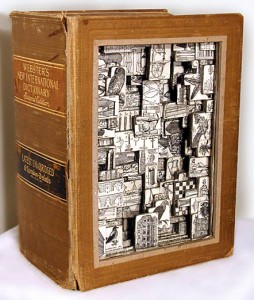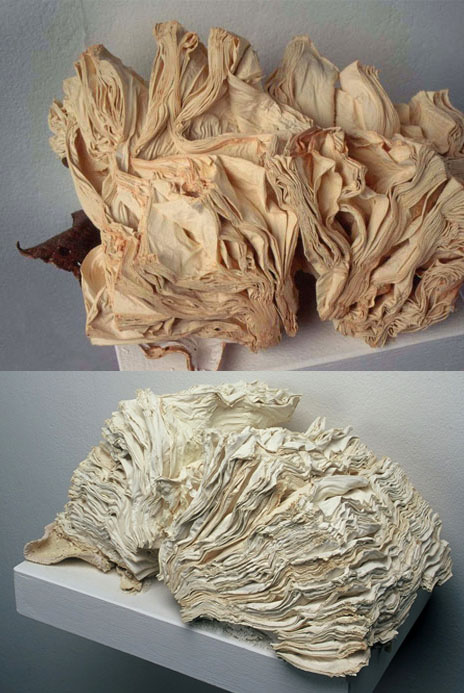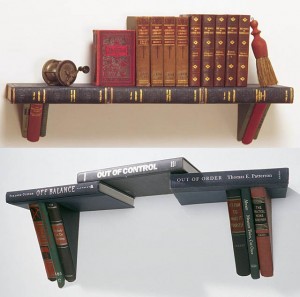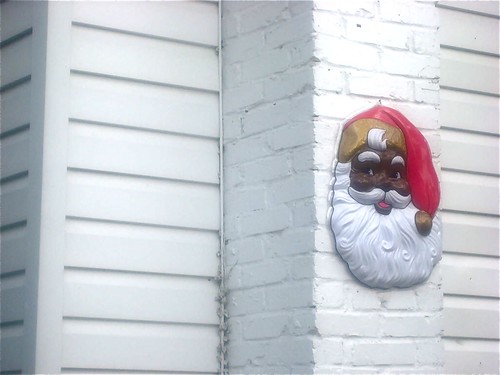
For sale right now on eBay: “A Tool To Deceive And Slaughter,” described as “a work of art … which consists of a black box that places itself for sale on the auction website ‘eBay’ (the “Auction Venue”) every seven (7) days. The Artwork consists of the combination of the black box or cube, the electronics contained therein, and the concept that such a physical object ‘sells itself’ every week.” The artist is Caleb Larsen.
Before you bid, you have to agree to terms (see the listing) which basically boil down to the imperative that you must let the object go back on sale on eBay, a week after your winning bid. If it sells for more than you paid for it, you pay the artist a 15% commission on your profit. If it doesn’t sell, you can keep it — but it will try again in a week. Basically you can the thing for as long as it doesn’t appreciate in value. (“Any failure to follow these terms without prior consent of Artist will forfeit the status of the Artwork as a legitimate work of art. The item will no longer be considered a genuine work by the Artist and any value associated with it will be reduced to its value as a material object and not a work of art.”)
Bidding is currently at $4,250.00.
(I learned of this via Metafilter. Reading deep into the comments I find that Murketing.com played an indirect role in the realization of Stephanie Syjuco’s “Temporal Aggregate / Social Configuration (Borrowed Beuys)” piece, which involved recreating a Beuys sculpture with objects she borrowed; evidently one of her lenders read about it here — resulting in a very, very rare moment when I sort of maybe think this site is worthwhile.)
The BBC radio series, A History of The World in 100 Objects has gotten underway, and I’m really into it. It’s written and hosted by the director of the British Museum, Neil MacGregor. Each episode lasts about 15 minutes, and the first one makes a brief case for history-via-objects by considering the Mummy of Hornedjitef, from the 3rd century B.C., described as “one of the most impressive mummy cases” in the British Museum. Like other objects this one sends the sort of “signals from the past” that things can carry. Since it arrived at the museum in 1835, scholars have translated the hieroglyphics and learned about the society the object came from, studied the charms and amulets entombed with the deceased to deduce that society’s beliefs about journeys of the afterlife, and examined its physical makeup to extrapolate the trading networks of the age. Such objects keep sending new signals, as scholars figure out how to receive them.
In the second episode MacGregor dials us back to the beginning of his story: a 1.8 million-year-old “stone chopping tool” found in Olduvai Gorge, in Tanzania (by a Ricahrd Leakey expedition, under the auspices of the British Museum). Discovered next to bones, the chopping tool seems to have been shaped to strip meat and break into the bones of killed wildebeests and the like. “A very, very versatile kitchen implement,” MacGregor offers.
Although the series is explicit in telling the story of human history by way of things humans have made, I think a history of humanity told via objects ought to start with the Makapansgat Pebble (below). As you can see, it looks like a face. It was found in what is now South Africa, and is estimated to be about 3 million years old. What’s significant about it is that the experts believe, based on the makeup of the pebble, that the spot where they found it, among ancient bones and whatnot, indicate that some hominid/human ancestor carried the thing several miles, which would make it the oldest known manuport.

Makapansgat Pebble
Why was carried away from its place of origin? Well, obviously we don’t know the precise answer, but clearly it’s not a matter of use-value: The pebble is not functional, it’s not a tool. I once heard Mia Fineman, a Met curator and writer, give a talk in which she brought up the Makapansgat Pebble in the context of pareidolia. Pareidolia basically involves spotting patterns that are basically random and attributing meaning to them — like seeing the Virgin Mary’s face in a grilled-cheese sandwich. Possibly the proto-human believed that there was something supernatural about a pebble that looked like a person. Please continue…
Here’s an essay I wrote in connection with Rewind Remix Replay: Design, Music & Everyday Experience, an exhibition at the Scottsdale Museum of Contemporary Art, through May 23, 2010. It’s available over there as well, but only as a PDF. So I figured I’d post it here. It’s a bit of an unusual piece for me, and I’m not certain how well I carried it off, but it was fun to write. I welcome feedback…
SITE AND SOUND:
One Home, Sixteen Objects, and the Things We Listen To Now
Surely the first decade of the 21st century will be remembered as a pivotal time in the history of listening. But it won’t be because of a new genre that burst on the scene, the way rock, rap, punk, even disco, changed the music we listen to. It will be because of the objects and technologies that changed the way we listen. Such transitions always seem abrupt (especially as they’re treated in the popular press) but unfold more gradually for most real-life listeners.
So as the decade wound down, I decided to conduct an inventory of objects and devices for music-listening in my own home. I’m more of a music fan than a gadget fan, which leads me to embrace music-oriented technology faster than any other sort (I owned an iPod before I owned a cell phone). At the same time, I can be slow to chuck old formats and objects just because something new has appeared; possibly the more dated relics of twentieth–century listening technology cluttering my home ought to have been discarded by now. But since analog and digital coexist in this particular environment, it’s an opportunity for a useful one-listener object ethnography. Please continue…
Every year right about this time I remind people: Please contribute photos taken on MLK Boulevards, Drives, Streets, Avenues, etc., anywhere, to the MLK BLVD Flickr pool, an open-source photojournalism project. Highlights appear on the blog MLK BLVD. The image above, from an MLK parade on MLK in New Orleans.
[For the three of you who read the No Notes blog: This is a cross-post.]
Posted Under:
Uncategorized by Rob Walker on January 18, 2010
Comments Off on MLK BLVD
The January 2010 issue of The Believer has an interesting book review — interesting in that the reviewer, Justin Taylor, was prevented from knowing anything about the book: who wrote it, who published it, to what genre it belonged, etc. “Its covers, front matter, and endpages had all been stripped, and the spine blacked out with a Sharpie.”
Toward the end of the review, Taylor addresses the “sensory-deprivation school of reading” he’d just experienced:
Jacket copy does more than simply entice you to buy. It supplies a framework for one’s experience. It is less a movie trailer than a placard on a museum wall, telling you not just how to look at the painting, but what to see there when you do.
I think that’s a very good point. Taylor adds some positive words about being a reader “freed from the tyranny of the preprogrammed response.” That’s an interesting notion, too.
That said, physical books will continue to have covers, front matter, blurbs, and other elements of the “framework” Talyor describes. In my (limited) experience, publishers do think of these things as something like a movie trailer or advertisement. That is, they think about the cover design and title and so on in terms of potential readers: How to attract them, get their attention, hook them, reel them in. Will a shorter subtitle grab more people? What snappy language on the flap is most likely to lead to a sale? Is the cover bold enough to stand out from the pile at Barnes & Noble? Etc.
I wonder how these things might be different if they were created with actual readers in mind: Not the person wandering through the bookstore, but the person who has bought the book and is reading it. Would this affect the look of the book, the nature of the jacket copy, maybe even its title? Would the “framework” have more to do with reinforcing (or even influencing) the reading experience, and less to do with the point -of-sale experience? (To use/abuse Taylor’s terms, if these things were thought of more as a placard in a museum and less as a blaring moving trailer.)
Maybe there would be less difference than I assume. But it might be an interesting experiment or design assignment, to think about how a book would look, and how its jacket copy etc., would read, if it were crafted not for the potential buyer, but for the actual reader.
Where, Larry King asks, is the real flying saucer?
I think that’s the phrase he uses, “flying saucer.” His guest is that guy Richard Heene, the guy at the center of the “balloon boy” thing. I first heard about that “story” by way of some report that it was all a hoax. All America was transfixed by this event, and it was a hoax! That’s what the story said. I had no idea what it was referring to. “Balloon boy”? I guess I was busy at the time.
Anyway so that was weeks ago. And now there’s this Larry King rerun, and I’m not really watching because I’m doing some tedious computer work, and if I understand correctly, this guy, Heene, is on his way to prison. But first he’s stopping by Larry King, to more or less imply that it wasn’t really a hoax; it was a misunderstanding. Or something.
Now he and Larry King are standing in front of what has just been described as replica of the “flying saucer” that this guy claimed his kid got into, and floated off into the ether. Only that didn’t rally happen. And so now he’s going to prison.
So: The police have it. That’s Heene’s answer to the question of where the real flying saucer is. King nods. When is the last time Larry King actually gave a shit about the people he talks to, the stories they tell?
The guy, Heene, is very animated, describing the object that he and King are standing in front of. This is a replica of an object that was briefly believed to be involved in a bizarre incident that in fact did not occur.
For a minute I look at the television set, stop what I’m doing. I’ve not laid eyes on Heene before. He has a very strange haircut. Larry King’s posture isn’t so great. But I guess he’s pretty old.
I have no idea what Heene is talking about. He says he didn’t do anything wrong. He looks wounded.
I should describe the “flying saucer.” It’s a big, silver…. Um…
…. Um, who fucking cares? What difference does it make what it looks like? Is there a prop department at CNN? I guess there must be. What does that suggest about the nature of information distribution, of news, today? What is like to build a prop … for the news? Who is in charge of making sure that the simulacrum of the thing that was at the center of a hoax – of a non-event – is, you know, up to snuff?
Where, Larry King asks, is the real flying saucer?
The answer, obviously, is that there is no real flying saucer.
And, somehow, that fact, that nonfact, is why we are here.
 Or maybe it was yesterday. Either way, Buying In: What We Buy and Who We Are
Or maybe it was yesterday. Either way, Buying In: What We Buy and Who We Are is now out in paper. It has a yellow cover. And a shorter subtitle. I made a couple of corrections of typos in the original book, but otherwise it’s the same, only cheaper. And with a yellow cover and… etc.
is now out in paper. It has a yellow cover. And a shorter subtitle. I made a couple of corrections of typos in the original book, but otherwise it’s the same, only cheaper. And with a yellow cover and… etc.
If you’re an educator who might want to assign the book, I might be able to get you a freebie to evaluate. Students seem to respond to it well, and I had great experiences doing Skype visits to classes in connection with the book last year. Contact is murketing@robwalker.net if you’re interested.
I am doing that, this month. If you miss the old linkpiles, maybe you’ll like what I contribute over there, to Coudal’s Fresh Signals feed.
Posted Under:
rw by Rob Walker on January 4, 2010
Comments Off on Guest-editing on Coudal.com

As noted.
So, no column again today because, as noted last week, Consumed is on hiatus until late March. I’m not going to announce this every week obviously, but I got some questions about this and the short answer is there’s nothing dramatic going on, good or bad. I’ve just been doing the column for six years now, and asked for a little break to work on some other things. My delightful editors were kind enough to let me do that. (And after all I’m a freelancer, so it’s not like it’s costing them anything if I produce less for them for a little while.) So that’s pretty much the whole story! No worries, no secrets.
Happy new year…
Posted Under:
rw by Rob Walker on January 3, 2010
Comments Off on Re: Hiatus
Well it’s January 1 and thus time once more to look back at my personal listening data to see if it can help me name my 10 favorite songs of 2009. (I have previously conducted this empirical-subjective exercise for 2007 and 2008.)
Here’s the Top Ten, followed by the number crunching.
[table id=1 /]
As in the past, I start out by seeing which songs I played most often, per iTunes data. And I cross-match that with my one-out-of-five-stars rating, and tweak accordingly. “Out At Sea” by Heartless Bastards was my most-played song of 2009 that was also released in 2009, according to my iTunes. This lines up with the subjective view: It probably is my favorite song of the year, it’s awesome, and perhaps if it ends up in a car commercial or whatever it’ll get the respect it deserves.
“Bumpo” was probably my favorite thing from Nomo’s record, but I pared away some others that I listened to almost as much. The next few tunes I’d say the playcount lines up with subjective liking. “Le Petit Sauvage” at number 6 is a bit of a cheat: I seem to like it more than I’ve played it.
The next several tunes all need some kind of comment. I’m late to the game on “How You Like Me Now,” by The Heavy, which I gather became well-known early in the year by way of a TV show or something; I only heard it pretty recently, and I think the low play count reflects the fact that I haven’t had it that long. A similar issue (recent-ish release) made me cheat “Bad Romance” past other stuff I’ve played more often. The Bran Flakes put out an interesting record, but I had to exercise subjectivity to pick “Stumble Out of Bed” as the best track; I actually listened to “Van Pop” more frequently (and that’s also really good). (In retrospect, however, I wish I’d just gotten a few Bran Flakes songs, not the whole album.)
Props to Disquiet and its regular postings of free, legal downloads, for being the source of two of my faves: Shoebomber’s “Le Petit Sauvage,” and the Grassy Knoll re-invention of Junior Kimbrough, “Done Got Old.”
Missing the top ten by a narrow enough margin that subjectivity easily could have put them over the top if I’d been in a slightly different mood. “Good Eye,” by Bruce Springsteen, because although the record isn’t great, this song is; “Crystalized” by The xx (I first heard it via Popcop); “It’s a Rainbow (Blame Me),” by Lisa Germano, which is from The Believer‘s music issue; “Space City,” by Booker T, because as much as I listened to his pleasing 2009 album, I think the whole beats the parts; “Las Hadas” by Juan Son (I heard it via DJ/Rupture’s site); and “The More I Do,” by The Field.
I also took a look at some data collected by LastFM, and another site I learned of this year (via Music Machinery), called Normalisr, which dips into your LastFM data and tracks your listening by time, instead of by number of plays. More, including my favorite non-2009 songs of 2009, after the jump. Please continue…
[ NOTE: This is a retroactive cross-post from SignificantObjects.com. That is to say, I wrote it for that site, with a view to making a point about how our project is a form of upcycling — but because it’s done with words, not by physically altering low-value objects, we get no “green” cred from the people who are in charge of doling out said cred. I partly made the point by noting that art that involved destroying (presumably unwanted) books gets props by converting these vessels for words into raw material; meanwhile, actual words don’t get the same respect. That was sort of my point, anyway. Since then, since I’ve been doing the books: the idea series, and this stuff relates to it, I’ve retroactively ported a cross-post over here, giving it the same date that it appeared on S.O. I hope that’s okay! ]

By Brian Dettmer
Significant Objects has many obvious virtues — but is it eco-friendly, too?
In the early days of trying to drum up traffic, I brought our project to the attention of several eco-blog types. Why? Because we figured that in converting near-worthless thrift-store junk into valuable and meaningful objects, our project was in effect upcycling with words.

By Jacqueline Rush Lee
I guess I did a bad job making this case, because none of the eco-bloggers bit, and it beats me why that is. Okay, so we’re not converting metric tons of spent plastic water bottles into hip t-shirts or somesuch. But surely if a sculptor incorporated some of the very same doodads you’re used to seeing on this site into a physical work of art and displayed it in a gallery, anybody would recognize that action as redeeming a bit of borderline junk with no particular use-value. Aren’t our writers doing the same?
Probably as a result of this I’ve been interested lately in examples of upcycled art and design that uses one specific form of object as its base material: the book.

By Jim Rosenau
This rather astounding roundup at Dark Roasted Blend (which I used to find the images for this post; click on any picture to go to the artist’s site) will provide you every example you need of books converted into pure objects; whatever words they contain hardly matter.
But I’m not here to rattle on about the special-ness of physical books and whatnot, as there are plenty of people around doing that already. And besides, a lot of these book-repurposings are pretty cool. I respect the artistry and craft involved. Speaking of artistry and craft, what I am here to do is say it loud and proud: The writers who’ve been participating in the Significant Objects project are also deploying their artistry and craft in a way that redeems borderline junk with no particular use-value. Please continue…

The truly brilliant among you noticed that last week’s column included a note specifying that Consumed is on hiatus until late March (thus: no column in today’s magazine, you see).
Meanwhile, I’ll continue to post links of note at the Consumed Facebook page. Also of course the action will continue unabated at Significant Objects, where I sometimes contribute actual writing in additional to my, uh, curatorial skills.
And there’s always the fascinating MKTG Tumblr, and the scandalously underrated Things That Look Like Other Things, and all the other stuff hyped in the sidebars on this very site, all for your entertainment and edification. Oh, and here’s something I wrote for The Awl. Enjoy it all, why don’t you.
The Murketing Organization encourages you to enjoy the season.
Posted Under:
Murketing.com by Rob Walker on December 25, 2009
Comments Off on Merry, Happy, Glad, Good
 STUFFED:
STUFFED:
A TV reality series suggests the thin line between our national consumer frenzy — and psychopathology
…. Hoarding, he says, has “more to do with a person’s psyche than their taste in decorating.” Given how dark that psyche can be, why do people watch? Sharenow offers several reasons, from the visual wallop to the raw narrative drama. “There’s something kind of Joycean about watching a hoarder,” he continues. “You’re getting this incredibly deep picture of their entire existence in a way, through the objects and through the stuff they accumulate.” ….
It’s interesting then that “Hoarders” has found its audience now. In a sense, the show can be read as a metaphor for an entire culture that has lost perspective on the relative importance of things and desperately needs help.
Read the column in the December 20, 2009, New York Times Magazine, or here.
Discuss, make fun of, or praise this column to the skies at the Consumed Facebook page.
Posted Under:
Consumed by Rob Walker on December 19, 2009
Comments Off on In The New York Times Magazine: “Hoarders”
 A REAL FIND?
A REAL FIND?
A furniture maker hypes its wares by leaving them out with the trash.
In early November, a marketing agency’s “street team” began scattering a client’s products on the sidewalks of Manhattan and Brooklyn….
Read the column in the December 6, 2009, New York Times Magazine, or here.
Discuss, make fun of, or praise this column to the skies at the Consumed Facebook page.
Posted Under:
Consumed,
Murketing by Rob Walker on December 5, 2009
Comments Off on In The New York Times Magazine: Blu Dot’s Real Good Chair promotion




 "
"










 STUFFED:
STUFFED:











 Kim Fellner's book
Kim Fellner's book  A
A